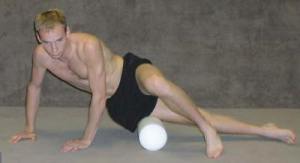
Roll and Stretch Away Your Tightness!
In our September newsletter we discussed a recent study on the positive impact foam rolling has on knee flexibility (1). The study found that foam rolling the quadriceps muscles increased range of motion during knee flexion without impacting strength and power output. A few days before our September newsletter hit the internet, an article appeared in the Wall Street Journal citing the same foam roller study as well as an additional study that was published in the November issue of the Journal of Sport Rehabilitation (2). This study found that a combination of stretching AND foam rolling was more effective at improving range of motion into hip flexion than just stretching by itself OR just rolling by itself. Taken together, these two studies begin to provide an outline of the most effective ways to utilize the foam roller.
What should you do?
Pre-exercise
Foam rolling should be a regular part of your warmup routine. We recommend foam rolling first, followed by dynamic stretching. The amount of time you spend rolling will vary depending on your level of tightness, the temperature, the time of day and the activity you are preparing for. As a general guideline, you should spend between 5 and 10 minutes rolling before starting your dynamic stretching.
Post-exercise
After working out, foam roll first and then engage in static stretching. You should generally spend more time rolling after you workout. The more you need to improve your flexibility, the more time you should spend rolling. You should roll somewhere around 10 to 15 minutes after exercise. Make sure to experiment with varying amounts of time to find out what works most effectively for you.
General Guidelines
* Ease into the muscle tissue slowly. Start with less pressure and then gradually increase the pressure as the tissue begins to soften and loosen. Err on the side of caution.
* Stay on soft tissue. Rolling over bony structures can cause or exacerbate irritation.
* Pay attention to your entire body. Using the roller can often times put you in awkward positions. Optimal use does require effective positioning which will also promote better body awareness. This is not always intuitive. Proper guidance can help tremendously. Check in with your therapist or personal trainer if you need coaching for effective positioning and body awareness.
If you have any questions on the foam roller and/or stretching, please don’t hesitate to contact us. You can also check out the additional resources below:
(1) MacDonald GZ, Penney MD, Mullaley ME, Cuconato AL, Drake CD, Behm DG,Button DC. “An acute bout of selfmyofascial release increases range of motion without a subsequent decrease in muscle activation or force.” Journal of Strength and Conditioning Research March 2013: 81221.
(2) Johannes, Laura. “Can Foam Rollers Help Relieve Muscle Pain?” The Wall Street Journal September 8, 2014.

